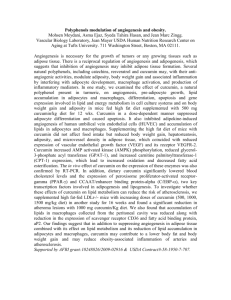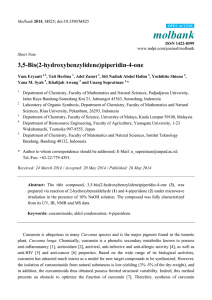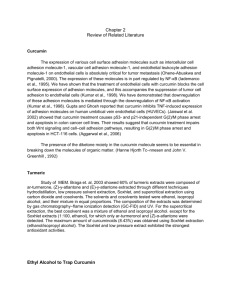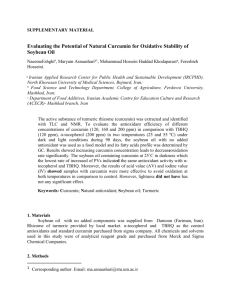Curcumin Derivatives in Experimental Diabetes
advertisement
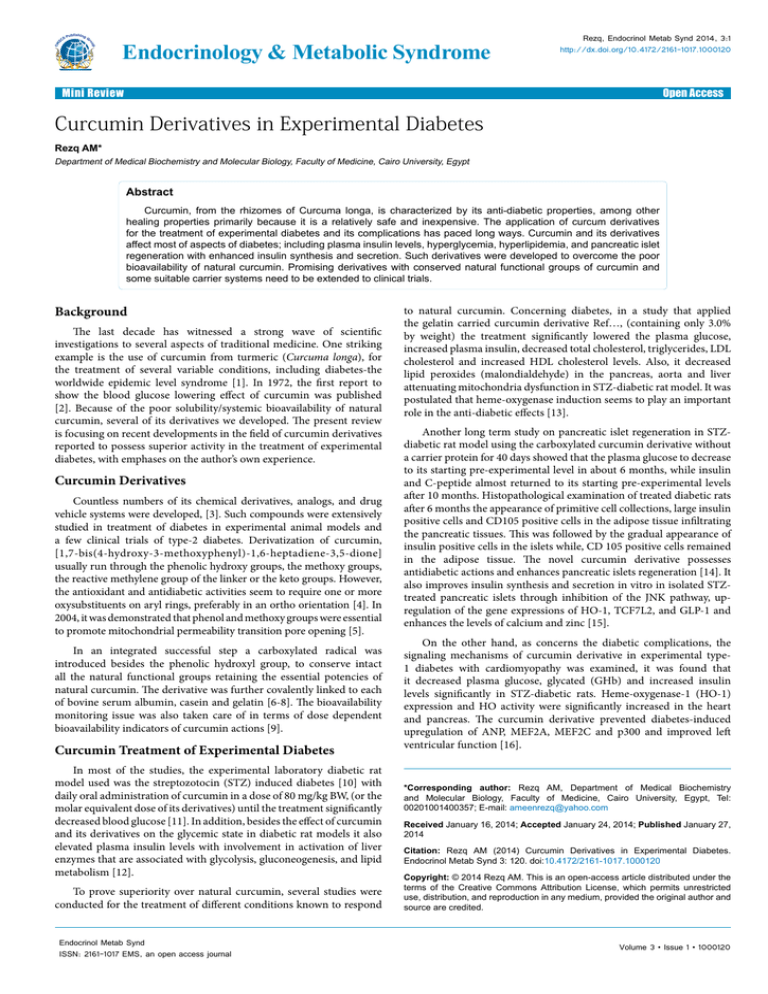
Endocrinology & Metabolic Syndrome Rezq, Endocrinol Metab Synd 2014, 3:1 http://dx.doi.org/10.4172/2161-1017.1000120 Mini Review Open Access Curcumin Derivatives in Experimental Diabetes Rezq AM* Department of Medical Biochemistry and Molecular Biology, Faculty of Medicine, Cairo University, Egypt Abstract Curcumin, from the rhizomes of Curcuma longa, is characterized by its anti-diabetic properties, among other healing properties primarily because it is a relatively safe and inexpensive. The application of curcum derivatives for the treatment of experimental diabetes and its complications has paced long ways. Curcumin and its derivatives affect most of aspects of diabetes; including plasma insulin levels, hyperglycemia, hyperlipidemia, and pancreatic islet regeneration with enhanced insulin synthesis and secretion. Such derivatives were developed to overcome the poor bioavailability of natural curcumin. Promising derivatives with conserved natural functional groups of curcumin and some suitable carrier systems need to be extended to clinical trials. Background The last decade has witnessed a strong wave of scientific investigations to several aspects of traditional medicine. One striking example is the use of curcumin from turmeric (Curcuma longa), for the treatment of several variable conditions, including diabetes-the worldwide epidemic level syndrome [1]. In 1972, the first report to show the blood glucose lowering effect of curcumin was published [2]. Because of the poor solubility/systemic bioavailability of natural curcumin, several of its derivatives we developed. The present review is focusing on recent developments in the field of curcumin derivatives reported to possess superior activity in the treatment of experimental diabetes, with emphases on the author’s own experience. Curcumin Derivatives Countless numbers of its chemical derivatives, analogs, and drug vehicle systems were developed, [3]. Such compounds were extensively studied in treatment of diabetes in experimental animal models and a few clinical trials of type-2 diabetes. Derivatization of curcumin, [1,7-bis(4-hydroxy-3-methoxyphenyl)-1,6-heptadiene-3,5-dione] usually run through the phenolic hydroxy groups, the methoxy groups, the reactive methylene group of the linker or the keto groups. However, the antioxidant and antidiabetic activities seem to require one or more oxysubstituents on aryl rings, preferably in an ortho orientation [4]. In 2004, it was demonstrated that phenol and methoxy groups were essential to promote mitochondrial permeability transition pore opening [5]. In an integrated successful step a carboxylated radical was introduced besides the phenolic hydroxyl group, to conserve intact all the natural functional groups retaining the essential potencies of natural curcumin. The derivative was further covalently linked to each of bovine serum albumin, casein and gelatin [6-8]. The bioavailability monitoring issue was also taken care of in terms of dose dependent bioavailability indicators of curcumin actions [9]. Curcumin Treatment of Experimental Diabetes In most of the studies, the experimental laboratory diabetic rat model used was the streptozotocin (STZ) induced diabetes [10] with daily oral administration of curcumin in a dose of 80 mg/kg BW, (or the molar equivalent dose of its derivatives) until the treatment significantly decreased blood glucose [11]. In addition, besides the effect of curcumin and its derivatives on the glycemic state in diabetic rat models it also elevated plasma insulin levels with involvement in activation of liver enzymes that are associated with glycolysis, gluconeogenesis, and lipid metabolism [12]. To prove superiority over natural curcumin, several studies were conducted for the treatment of different conditions known to respond Endocrinol Metab Synd ISSN: 2161-1017 EMS, an open access journal to natural curcumin. Concerning diabetes, in a study that applied the gelatin carried curcumin derivative Ref…, (containing only 3.0% by weight) the treatment significantly lowered the plasma glucose, increased plasma insulin, decreased total cholesterol, triglycerides, LDL cholesterol and increased HDL cholesterol levels. Also, it decreased lipid peroxides (malondialdehyde) in the pancreas, aorta and liver attenuating mitochondria dysfunction in STZ-diabetic rat model. It was postulated that heme-oxygenase induction seems to play an important role in the anti-diabetic effects [13]. Another long term study on pancreatic islet regeneration in STZdiabetic rat model using the carboxylated curcumin derivative without a carrier protein for 40 days showed that the plasma glucose to decrease to its starting pre-experimental level in about 6 months, while insulin and C-peptide almost returned to its starting pre-experimental levels after 10 months. Histopathological examination of treated diabetic rats after 6 months the appearance of primitive cell collections, large insulin positive cells and CD105 positive cells in the adipose tissue infiltrating the pancreatic tissues. This was followed by the gradual appearance of insulin positive cells in the islets while, CD 105 positive cells remained in the adipose tissue. The novel curcumin derivative possesses antidiabetic actions and enhances pancreatic islets regeneration [14]. It also improves insulin synthesis and secretion in vitro in isolated STZtreated pancreatic islets through inhibition of the JNK pathway, upregulation of the gene expressions of HO-1, TCF7L2, and GLP-1 and enhances the levels of calcium and zinc [15]. On the other hand, as concerns the diabetic complications, the signaling mechanisms of curcumin derivative in experimental type1 diabetes with cardiomyopathy was examined, it was found that it decreased plasma glucose, glycated (GHb) and increased insulin levels significantly in STZ-diabetic rats. Heme-oxygenase-1 (HO-1) expression and HO activity were significantly increased in the heart and pancreas. The curcumin derivative prevented diabetes-induced upregulation of ANP, MEF2A, MEF2C and p300 and improved left ventricular function [16]. *Corresponding author: Rezq AM, Department of Medical Biochemistry and Molecular Biology, Faculty of Medicine, Cairo University, Egypt, Tel: 00201001400357; E-mail: ameenrezq@yahoo.com Received January 16, 2014; Accepted January 24, 2014; Published January 27, 2014 Citation: Rezq AM (2014) Curcumin Derivatives in Experimental Diabetes. Endocrinol Metab Synd 3: 120. doi:10.4172/2161-1017.1000120 Copyright: © 2014 Rezq AM. This is an open-access article distributed under the terms of the Creative Commons Attribution License, which permits unrestricted use, distribution, and reproduction in any medium, provided the original author and source are credited. Volume 3 • Issue 1 • 1000120 Citation: Rezq AM (2014) Curcumin Derivatives in Experimental Diabetes. Endocrinol Metab Synd 3: 120. doi:10.4172/2161-1017.1000120 Page 2 of 2 The gelatin covalently linked curcumin derivative enhanced erectile function in diabetes induced erectile dysfunction by increasing intracavernosal pressure (ICP), cGMP levels, HO-1, eNOS, neuronal NOS (nNOS), and Nrf2 with significant reductions in NF-KB, p38, and iNOS [17]. Further, curcumin ameliorated STZ-induced testicular damage and apoptotic germ cell death by decreasing oxidative stress [18]. Other diabetic complications as neuropathy retinopathy and nephropathy are also ameliorated by curcumin treatment. An excellent more detailed review article on the present subject appeared on 2013 [19]. Conclusion The strong wave of ongoing research on the use of curcumin and its derivatives for the treatment diabetes and its associated disorders has confirmed the scientific basis for their role in this aspect. Curcumin and its derivatives affect most of aspects of diabetes, including plasma insulin levels, hyperglycemia, hyperlipidemia, and pancreatic islet regeneration. The novel curcumin derivatives enhances improves insulin synthesis and secretion in vitro in isolated STZ-treated pancreatic islets and enhances the levels of calcium and zinc. Clinical trials of curcumin or its derivatives to extend their value in the treatment of diabetes and other associated disorders are very limited so far. Promising derivatives with conserved natural functional groups of curcumin and some suitable carrier systems seems a reasonable approach in view of the recent experimental data that needs to be extended to clinical trials. References 1. Nolan CJ, Damm P, Prentki M (2011) Type 2 diabetes across generations: from pathophysiology to prevention and management. Lancet 378: 169-181. 2. Srinivasan M (1972) Effect of curcumin on blood sugar as seen in a diabetic subject. Indian J Med Sci 26: 269-270. 3. Fan X, Zhang C, Liu DB, Yan J, Liang HP (2013) The clinical applications of curcumin: current state and the future. Curr Pharm Des 19: 2011-2031. 4. Anand P, Thomas SG, Kunnumakkara AB, Sundaram C, Harikumar KB, et al. (2008) Biological activities of curcumin and its analogues (Congeners) made by man and Mother Nature, biochemical pharmacology 76: 1590-1611. 5. Ligeret H, Barthelemy S, Zini R, Tillement JP, Labidalle S, et al. (2004) Effects of curcumin and curcumin derivatives on mitochondrial permeability transition pore. Free Radic Biol Med 36: 919-929. 6. Abdel Aziz MT, El Asmer MF, Rezq A, Kumosani TA, Mostafa S, et al. (2010) Novel water-soluble curcumin derivative mediating erectile signaling. J Sex Med 7: 2714-2722. 7. Rezq AM, Abdel Aziz MT, Al-Malki AL: Casein, a novel curcumin drug carrier system. WO/2011/100983. 8. Rezq AM, Abdel Aziz MT, Al-Malki AL: Gelatin, a novel curcumin drug carrier system. WO/2011/100984. 9. Abd El Aziz M, El-Asmer M, Rezq A, Al-Malki A, Kumosani T, et al. (2013) Dose-dependent bioavailability indicators for curcumin and two of its novel derivatives. Biofactors . 10.Pari L, Murugan P (2007) Tetrahydrocurcumin prevents brain lipid peroxidation in streptozotocin-induced diabetic rats. J Med Food 10: 323-329. 11.Arun N, Nalini N (2002) Efficacy of turmeric on blood sugar and polyol pathway in diabetic albino rats. Plant Foods Hum Nutr 57: 41-52. 12.Seo KI, Choi MS, Jung UJ, Kim HJ, Yeo J, et al. (2008) Effect of curcumin supplementation on blood glucose, plasma insulin, and glucose homeostasis related enzyme activities in diabetic db/db mice. Mol Nutr Food Res 52: 9951004. 13.Abdel Aziz MT, El-Asmar MF, El-Ibrashy IN, Rezq AM, Al-Malki AL, et al. (2012) Effect of novel water soluble curcumin derivative on experimental type-1 diabetes mellitus (short term study). Diabetol Metab Syndr 4: 1. 14.Abdel Aziz MT, El-Asmar MF, Rezq AM, Mahfouz SM, Wassef MA, et al. (2013) The effect of a novel curcumin derivative on pancreatic islet regeneration in experimental type-1 diabetes in rats (long term study). Diabetol Metab Syndr 5: 75. 15.Aziz MT, El-Asmar MF, Rezq AM, Wassef MA, Fouad H, et al. (2014) Effects of a novel curcumin derivative on insulin synthesis and secretion in treptozotocintreated rat pancreatic islets in vitro. Chinese Medicine, 9: 3. 16.Aziz MT, El Ibrashy IN, Mikhailidis DP, Rezq AM, Wassef MA, et al. (2013) Signaling mechanisms of a water soluble curcumin derivative in experimental type-1 diabetes with cardiomyopathy. Diabetol Metab Syndr 5: 13. 17.Abdel Aziz MT, Motawi T, Rezq A, Mostafa T, Fouad HH, et al. (2012) Effects of a water-soluble curcumin protein conjugate vs. pure curcumin in a diabetic model of erectile dysfunction. J Sex Med 9: 1815-1833. 18.Kanter M, Aktas C, Erboga M (2013) Curcumin attenuates testicular damage, apoptotic germ cell death, and oxidative stress in streptozotocin-induced diabetic rats. Mol Nutr Food Res 57: 1578-1585. 19.Zhang DW, Fu M, Gao SH, Liu JL (2013) Curcumin and Diabetes: A Systematic Review. Evid Based Complement Alternat Med 2013: 636053. Submit your next manuscript and get advantages of OMICS Group submissions Unique features: • • • User friendly/feasible website-translation of your paper to 50 world’s leading languages Audio Version of published paper Digital articles to share and explore Special features: Citation: Rezq AM (2014) Curcumin Derivatives in Experimental Diabetes. Endocrinol Metab Synd 3: 120. doi:10.4172/2161-1017.1000120 Endocrinol Metab Synd ISSN: 2161-1017 EMS, an open access journal • • • • • • • • 300 Open Access Journals 25,000 editorial team 21 days rapid review process Quality and quick editorial, review and publication processing Indexing at PubMed (partial), Scopus, EBSCO, Index Copernicus and Google Scholar etc Sharing Option: Social Networking Enabled Authors, Reviewers and Editors rewarded with online Scientific Credits Better discount for your subsequent articles Submit your manuscript at: http://www.omicsonline.org/submission/ Volume 3 • Issue 1 • 1000120
